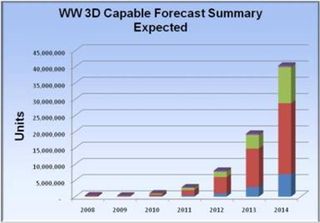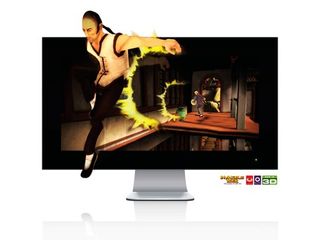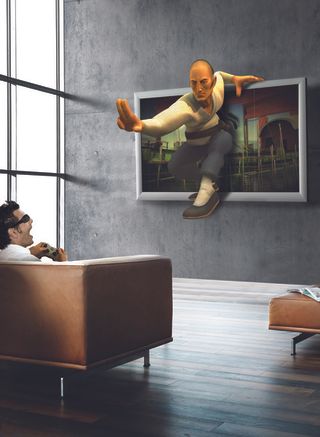Is 3D television just a great big swizz?
TechRadar uncovers the substance behind the 3D TV hype
The latest predictions from analysts would have us believe that there will be no less than 40 million 3D-capable screens worldwide by 2014. A phenomenal rate of growth over the next four years, should the prediction turn out to be anywhere near correct.
"We have just published a 330-page report on 3D gaming and TVs," says display industry analyst Chris Chinnock, CEO of Insight Media.
"So we have spent a number of years looking at 3D and this is our latest report with the focus on gaming and the forecasts for 3D-capable platforms – laptops, monitors, TVs and projectors – offering three different forecast 'scenarios' – expected, optimistic and conservative."

GOING 3D: Insight Media's 'expected' predictions for worldwide 3D-capable screen sales 2008 - 2014
Chinnock and his team of analysts at Insight have been careful to make their forecasting methodologies as transparent as they possibly could.
"There are so many factors at play here that any of these scenarios could occur," Chinnock told TechRadar. "At the 10,000-foot level, I think 2010 is kind of the introduction year for 3D gaming and other content. Many more of the factors in the ecosystem start to align in 2011. And in 2012 almost all the pieces are in place to start to make 3D more of a mainstream phenomenon."
Sony and Sky, of course, want to make 2010 a much more 'mainstream adoption' year. "And they might have some success," the analyst concedes, "Sky is in a unique position because of their ability to create content and control the distribution of the content via its satellites and set-top boxes - so they are in a very good position to create a more mainstream capability for consumers.
Get daily insight, inspiration and deals in your inbox
Get the hottest deals available in your inbox plus news, reviews, opinion, analysis and more from the TechRadar team.
"If you look at all the content that is out there in 3D today, gaming has by far the largest amount – and almost all of this is PC-based at this point, which is why we have focused in our gaming report on laptops and monitor-based experiences. But you are also starting to see the switchover to the availability of console-based 3D games now. [Ubisoft's] Avatar is the most important 3D game release to date."
One person who wholeheartedly agrees that gaming will drive the uptake of 3D TV in the lounge is Blitz Games Studios CEO, Andrew Oliver, perhaps the most vocal advocate of 3D in the home in Britain, having recently launched the first stereoscopic 3D console game, Invincible Tiger: The Legend of Han Tao for Xbox 360 and PS3. Oliver explained his passion for 3D entertainment tech in this guest post for TechRadar earlier in the year.

"It's no surprise to me that there will be a massive push on 3D this year at CES. CE companies can't deny the popularity and quality of the new 3D movies coming out of Hollywood. New TVs can produce exceptional quality 3D visuals with little extra technology and we've also proved that video games are possible and will look better in 3D. Everyone in the business knows 3D has finally come of age.
"I'm not expecting people who have bought a new flat panel TV to go out and buy a new, 3D enabled one. But I do expect all TV manufacturers to be offering optional 3D into most TVs in the next couple of years.
"People are always upgrading and next year they will have the choice to go for a TV that supports 3D or not. With Hollywood clearly making all the blockbusters in 3D and video games going into 3D, they have the option to pay a little extra for the extra level of immersion.

The problem here and now, of course, is that only a miniscule proportion of the console-gaming public are likely to own a TV to run Blitz's fantastic game on for the foreseeable near future.
Over-hyped and over here
To return to our original question, though, is there a danger of manufacturers over-hyping 3D TV at CES 2010?
"Well it's going to get hyped. For sure," says Chris Chinnock. "We know that there are going to be a number of significant 3D TV announcements made at CES and a lot of new 3D TVs unveiled. We are also going to see announcements relating to many of the infrastructure aspects, content-creation aspects, trial services, demos and so on. All the pieces are starting to come into place for people to start services and start the roll-out.
"Is that over-hyping? I don't know. Maybe not."
Meanwhile, Screen Digest's Tom Morrod is still adamant that 3D "is not going to be mainstream for several years," though he also helpfully adds that "a 3D TV bought next year is very unlikely to prove unusable in a few years time," because the 'format war' stuff is going to happen in distribution rather than in the displays.
For most, 3D will simply be something they discover on their new TV when they next upgrade it in 2015 or later. "Considering the uptake cycle for HD has been around five to six years to reach 30% penetration of total active TV sets and around 50% of households have at least one HD set we can probably project that it will be around 2016-2017 before we start reaching those kind of levels for 3D and probably looking at close to 100% of the households having at least one 3D TV by 2020 (all data for major established markets).
"Most people won't have to go looking for 3D, it will come to them."
Blitz Games boss Andrew Oliver adds that "this new 'hype' is no different to the early days of HD functionality in new TVs – for a lot of people it won't be of interest in the early stages but I'm confident that what is picked up now by the early adopters of technology will become standard in a couple of years for the broader market. This is a pattern that we've seen time and again and there's nothing to suggest it will be different this time."
So what have we learned? 3D TVs are going to be hyped at CES and throughout 2010. A lot. Gaming is going to drive quality 3D content on the TV. And Sky's 3D offering, while niche, should be of interest to a few of us later in the year. Providing it doesn't give you headaches.
And, if you are a hardcore gamer with a lot of money burning a hole in your pocket, you may as well shell out for a decent 3D TV asap, because it should suit your needs for the next five or so years.
By which point, we will no doubt start talking about next-gen SmellOvision TVs and 4D virtual spaces at CES 2015…

